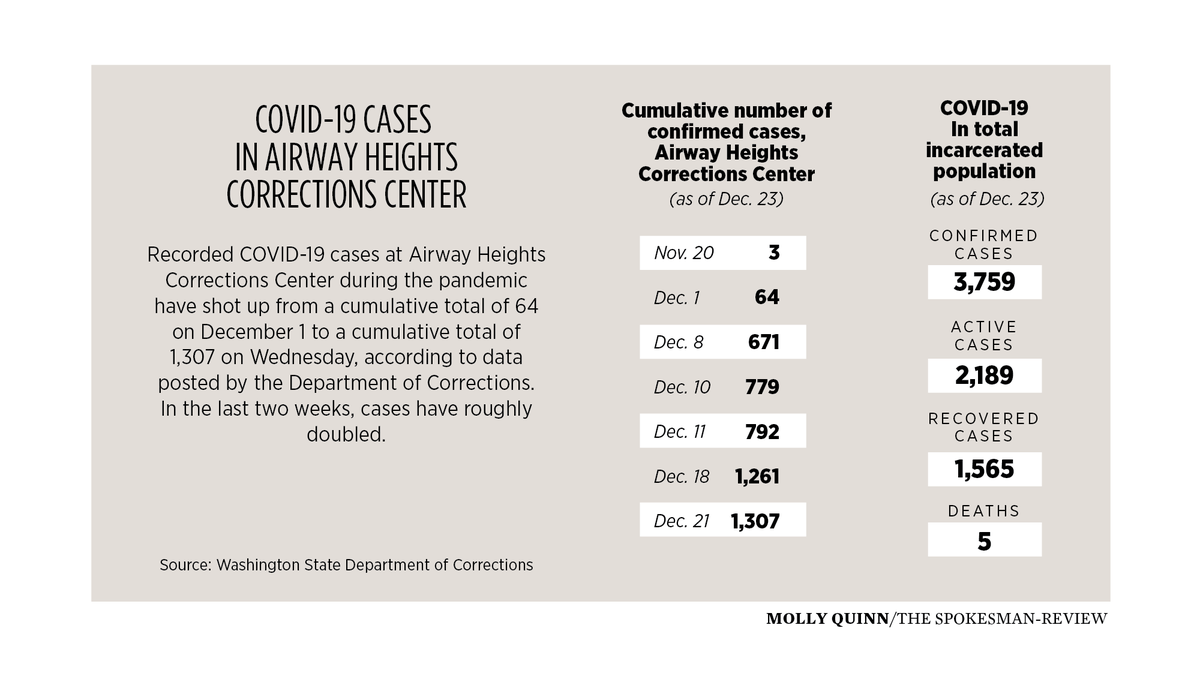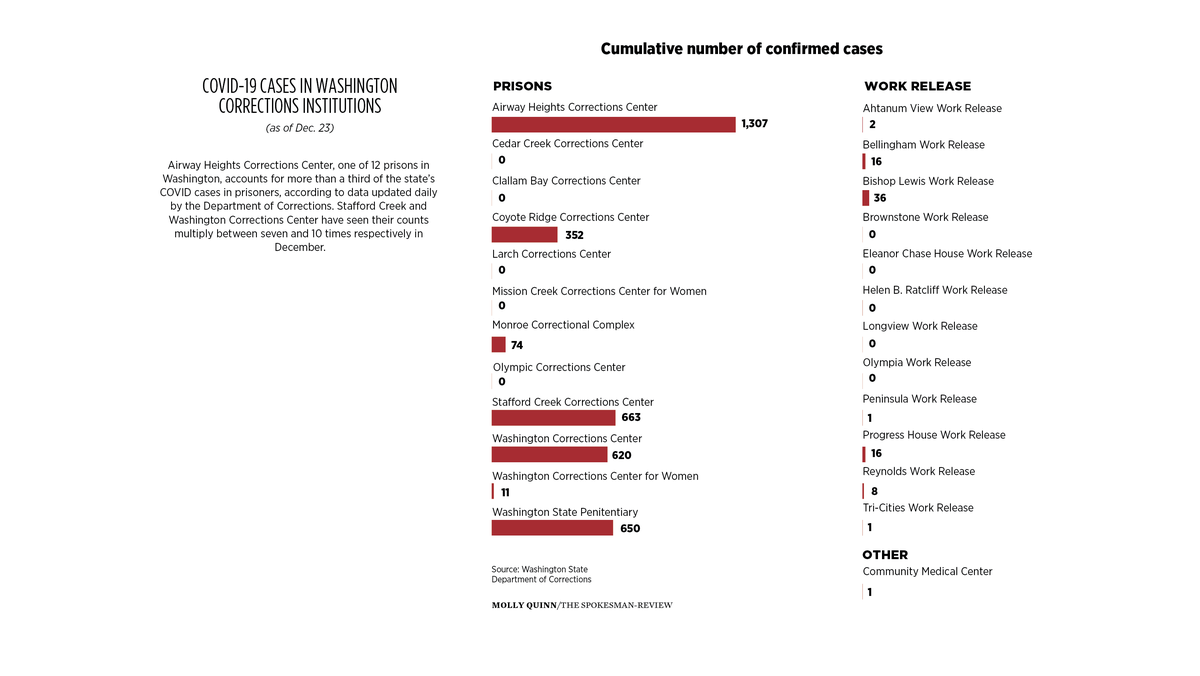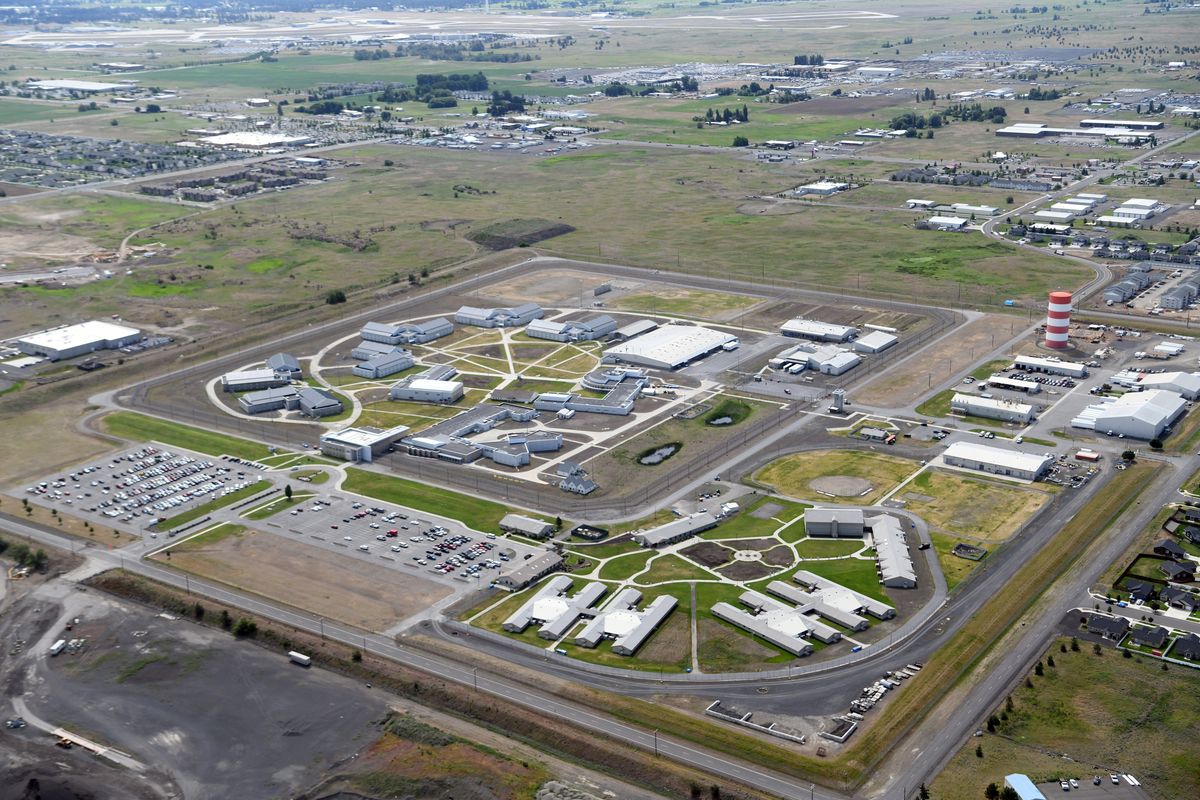70% of Airway Heights prison is COVID-19-positive
The Washington Department of Corrections has reported 70% of inmates in Airway Heights Corrections Center, photographed June, 4, 2018, has tested positive for COVID-19. (JESSE TINSLEY)
Seventy percent of Airway Heights Corrections Center’s inmate population have tested positive for COVID-19 and almost all those cases were recorded this month.
That’s 1,307 prisoners who have tested positive. Airway Heights is one of a dozen state prisons, but cases there account for a third of all the cases among all Washington state prisoners. On top of that 155 staff members at the prison have tested positive.
One Airway Heights inmate died last week. The Department of Corrections has not posted the number of inmates hospitalized from the West Plains facility.
When less than a third had tested positive in early December, inmate Tobin Sather described “decaying” conditions. In the gym where the sick were housed, 145 COVID-positive men shared four toilets, according to the Department of Corrections.
Sather, one of the sickest men in a COVID-19 care unit at the prison, described showering twice in 15 days, medical treatment limited to acetaminophen and broken toilets causing hours-long waits to relieve himself. He called the situation “obscene.” Since then, he said his medical care has degraded – no acetaminophen, no checks of his vitals.
While advocates call for a mass release of prisoners to reduce strain on the prison system, Gov. Jay Inslee said in a news conference last week he didn’t think releasing prisoners now would lead to a “significant improvement of conditions.”
The Department of Corrections did not respond to questions before the print deadline for this story.
During a news conference last week held by law firm Columbia Legal Services, formerly incarcerated people and advocates argued social distancing is not possible in prison and that overwhelmed staff could provide better care with fewer inmates.
The Department of Corrections proposed this August a similar “significant and permanent” reduction in the prison population to reduce their budget.
But since April, when Inslee ordered the release of more than 1,000 prisoners in response to COVID-19, the state hasn’t had any other large releases.
“Sometimes there are stories that are reported in our great media that just are not accurate,” Inslee said last week. “Sometimes rumors get started by individuals who are incarcerated that are frankly false.”
Mattlani Walker’s husband in the minimum security camp at Airway Heights has tested positive. Walker, who founded a group called Families of the Incarcerated, is connected with families of prisoners statewide who are describing lack of access to bathrooms, showers and medical care across the state, she said.
“Coyote Ridge people, they don’t talk to Walla Walla people,” Walker said, referring to two other prisons in Eastern Washington. “If you look at JPAY messages, they’re all the same but at different facilities. So how are they making that up?” JPAY is the prison messaging system.
Over email Wednesday, Tara Lee, spokesperson for the governor, did not specify which rumors Inslee was referring to last week. Department of Corrections staff have “repeatedly” told Inslee that there is enough space at Airway Heights, she said.
“This is less of an issue about adequate space for people to spread out and more about some incarcerated individuals’ willingness to utilize that space,” Lee said. “Incarcerated people are not forced into isolation.”
Lee said the governor recognizes “how important social contact is and understands the challenges related to this,” but believes there’s enough space.
Inmates like Sather are less concerned about space than poor conditions, he said.
“No clean clothes, no way of cleaning our clothes, limited access to showers if at all, not being able to just wash our bodies, generally not being able to use the restroom – those would be my biggest concerns,” Sather said Dec. 8. “Everything else we can live with.”
When only 40% of the prison’s population had tested positive, Sather said officers appeared exhausted and overwhelmed. Now, 155 staff members at Airway Heights have tested positive, according to the DOC’s count. Across the state system, 713 prison staff members have tested positive.
Prisoners who work in the kitchen and laundry became ill too. To deal with laundry and food production, DOC had requested resources but resources had been “increasingly difficult to find,” DOC spokesperson Susan Billers said Dec. 11.
The DOC planned to contract out laundry services and some elements of food production at Airway Heights starting Dec. 14, she said.
Walker said her husband in isolation has been receiving small, sometimes cold “TV dinners” and his lunch has come as late as 5 p.m. In response, she said people in his unit have started a hunger strike.
“I know some of the public believes that the incarcerated population deserves that, but it’s not humanity,” Walker said.
RetaliationSather said Dec. 14 he was transferred to an isolation unit where he did not see medical personnel for at least seven days.
The day prior, he said medical staff told him he needed his vitals checked daily due to his conditions – tachycardia, no spleen and fluid building up in his leg.
Sather thinks the move was retaliatory. He and several other inmates complained about long periods when toilets were out of order, he said. Those men were transferred, he said. Five days prior to the move, Sather had also been a source in a Spokesman-Review story about conditions in the facility.
The Office of the Corrections Ombuds found DOC staff at a facility across the state had made a similar potentially retaliatory move in May.
A prisoner’s family member had protested outside the prison over poor conditions May 1. The ombuds found staff had issued the inmate an unfounded infraction, removing 30 days of an earned sentence reduction for good behavior and disqualifying him for work release that he was scheduled to begin later that month.
In investigating the possible retaliation, the ombuds found the DOC had withheld relevant footage the ombuds requested to review.
“DOC staff engaged in a pattern of deceit and obstruction, potentially to fabricate a rationale for their actions,” the report reads.
Lee did not answer if the report has changed the governor’s mind about some incarcerated people’s complaints, but said the ombuds “has the full support of the governor and the information they provide is crucial to changing any culture or conditions that could be harmful to the people in DOC’s care.”
Lee did not say if the governor would meet with families of incarcerated people but said they are regularly in contact with Inslee’s staff. Inslee also won’t be visiting any state prisons to see conditions because he’s not traveling outside of Olympia for any reason, Lee said.
“Families are rightfully concerned about their loved ones and we want to make sure that those families get all the accurate, timely and relevant information about conditions,” Lee said. “Any loss of life is painful for everyone and we will continue to do whatever we can.”
Release
The Washington Supreme Court in a 5-4 decision this April rejected a lawsuit that would have forced Inslee and Department of Corrections Secretary Stephen Sinclair to release prisoners, though he moved to release more than 1,000 anyway.
The court’s order said the petitioners, represented by Columbia Legal Services, had not proved Inslee and Sinclair’s actions “constitute deliberate indifference” to people incarcerated in Washington.
But releases are still possible. As part of that lawsuit, a former head of the state’s Department of Corrections laid out four paths the DOC could take to release inmates without an order from the governor, saying it was “imperative” to “flatten the curve” for the sake of prisoners and prison staff.
“The best way to do this is to quickly implement strategies to reduce the population,” wrote former Corrections Secretary Dan Pacholke, who worked in the agency more than 30 years.
The DOC has authority under the furlough statute to release inmates on the grounds that they receive medical care unavailable in prison, he wrote.
Through the Graduated Re-Entry Program, Pacholke argued the DOC could release prisoners within six months of their estimated release date, so long as they’d already served 12 months. Through another state law, Department of Corrections Secretary Stephen Sinclair could place prisoners with serious medical conditions on Extraordinary Medical Placement in another care setting, in lieu of confinement.
Finally, Pacholke pointed to the DOC’s Community Parenting Alternative, which allows the Secretary to put a prisoner in home detention for the last year of their sentence, if it’s in the best interest of the prisoner’s minor children.
In the DOC’s budget strategy for the 2021-23 biennium, the DOC set similar goals to achieve the 15% budget reduction target set by the Office of Financial Management.
The DOC’s proposal included reducing the prison population by allowing incarcerated individuals with good housing plans, regardless of offense or sentence type, to serve the final 150 days of their sentence in partial confinement on electronic home monitoring.
The proposal also allowed more people to earn sentence reductions for good behavior, giving automatic earned time to people in prison who did not commit a crime against a person.
Under the same plan, people convicted of nonviolent, non-sexual crimes, including drug crimes, would serve “little to no time in a prison facility.” All but 120 days of convicted peoples’ sentences would be served on home monitoring or in partial confinement.
Editor’s note: This story has been edited to reflect that the Department of Corrections responded to a request for interview, but did not immediately answer questions.


